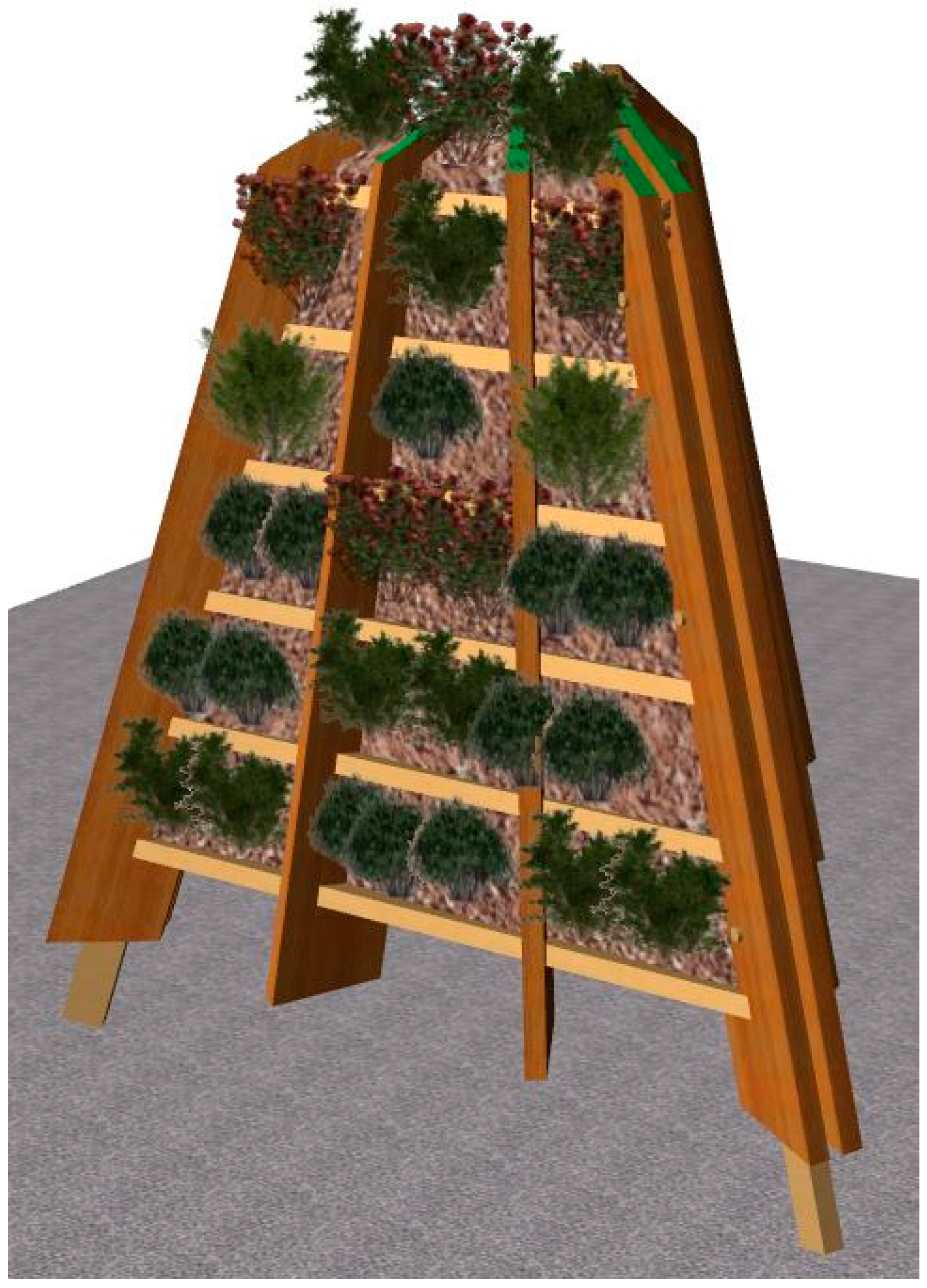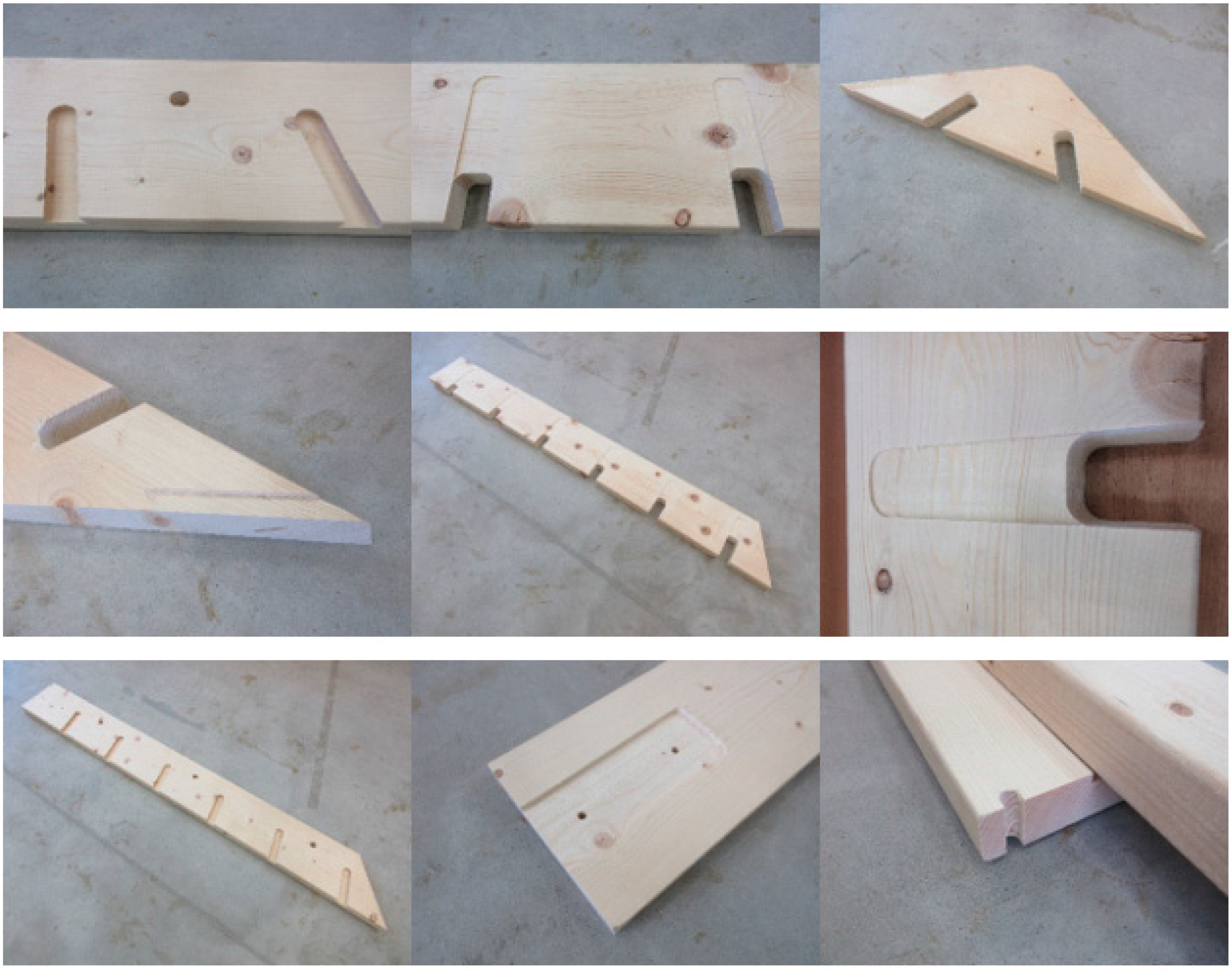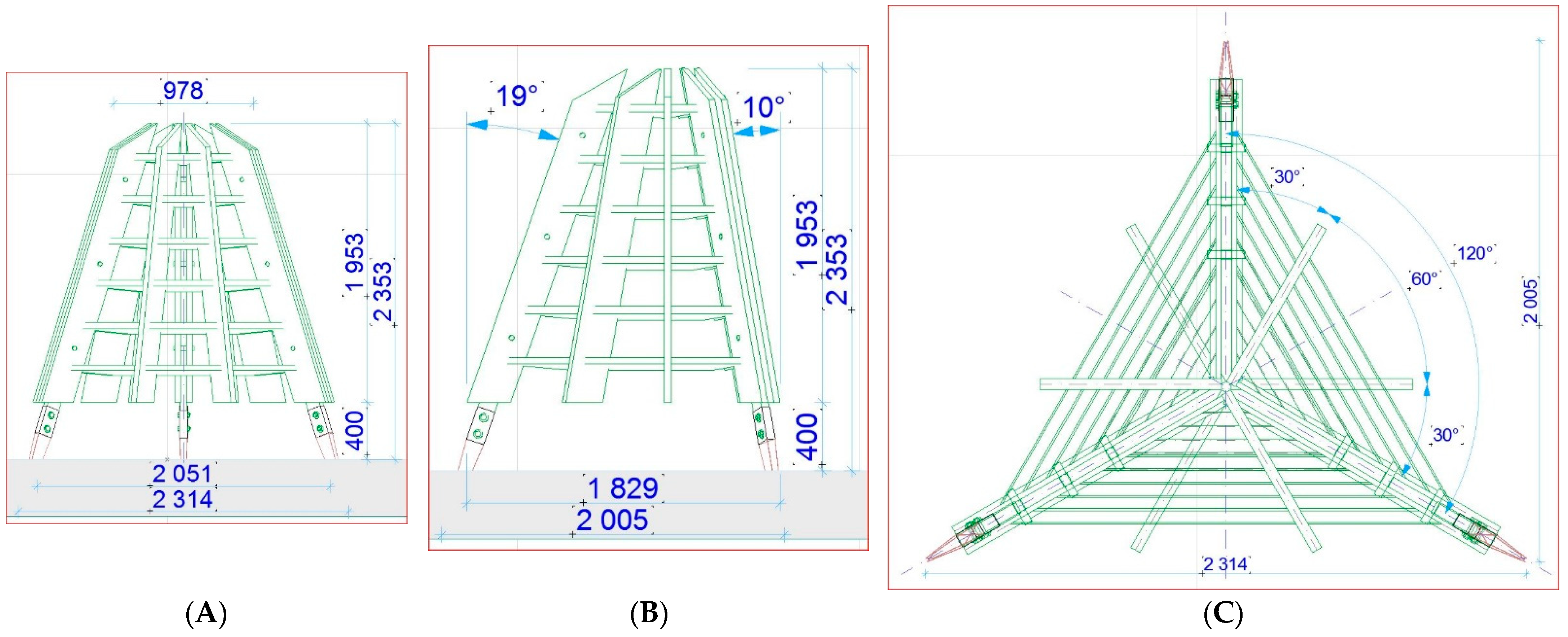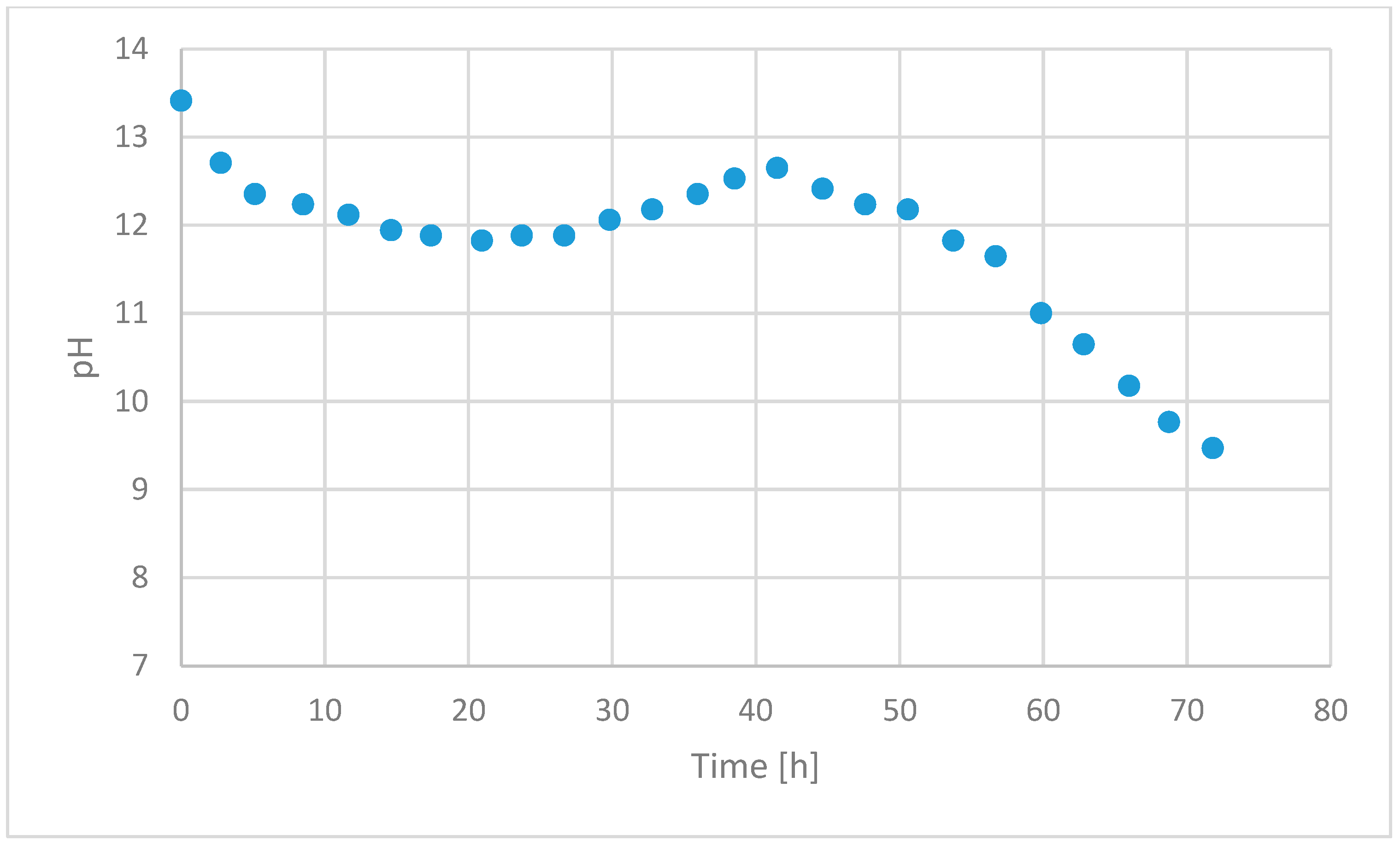Timber Structures and Prefabricated Concrete Composite Blocks as a Novel Development in Vertical Gardening
Abstract
1. Introduction
2. Materials and Methods
2.1. Timber Structures
2.2. Concrete Composite Substrates
- Different types of peat or other organic fillers;
- Mixture of different kukersite oil shale ashes; fly ash from pulverized firing, desulfurizing ash with high CaSO4 content and ash from incineration of oil shale in circulating fluidized bed process;
- Silica fume (nano-SiO2), unneeded by-product of metallurgy (waste), mainly of steel production [20];
- Sulfur, for fast lowering of the pH of the composite;
- Various nutrients for plants: mineral and micronutrients;
- Humates to buffer the environment.
3. Results and Discussion
3.1. Timber Structures
3.2. Concrete Composite Substrates
4. Conclusions
Author Contributions
Funding
Institutional Review Board Statement
Informed Consent Statement
Data Availability Statement
Acknowledgments
Conflicts of Interest
References
- Yücel, G.F. Vertical Landscape Desıgn. In Green Technology Applications for Enterprise and Academic Innovation; Ariwa, E., Ed.; IGI Global: Hershey, PA, USA, 2014; pp. 276–292. [Google Scholar] [CrossRef]
- Igaz, D., Gawroński, K., Eds.; E-ENVIRO. In Proceedings of the 24th International Scientific Conference, Kežmarské Žľaby, Slovakia, 21–23 October 2019; Slovak University of Agriculture in Nitra: Nitra, Slovakia, 2019. [Google Scholar]
- Ramirez, F.; Chuquer, D.; Espinosa, A.V.; Davis, M.M. Influence of vertical gardens on the air quality of a city historic center. In Proceedings of the 3rd European and Mediterranean Structural Engineering and Construction Conference, Beirut, Lebanon, 23–28 July 2018; ISEC Press: Fargo, ND, USA, 2020. [Google Scholar] [CrossRef]
- Abhijith, K.; Kumar, P.; Gallagher, J.; McNabola, A.; Baldauf, R.; Pilla, F.; Broderick, B.; Di Sabatino, S.; Pulvirenti, B. Air pollution abatement performances of green infrastructure in open road and built-up street canyon environments—A review. Atmos. Environ. 2017, 162, 71–86. [Google Scholar] [CrossRef]
- Ivanova, N.; Ganzha, O.; Podkovyrov, I. The use of the Analytic Hierarchy Process in Determination of the Design Solution for Vertical Gardening. J. Physics Conf. Ser. 2020, 1614, 012035. [Google Scholar] [CrossRef]
- Butturini, M.; Marcelis, L.F. Vertical Farming in Europe: Present Status and Outlook. In Plant Factory—An Indoor Vertical Farming System for Efficient Quality Food Production, 2nd ed.; Academic Press: Cambridge, MA, USA; Elsevier: Cambridge, MA, USA, 2020; pp. 77–91. [Google Scholar] [CrossRef]
- Shao, Y.; Li, J.; Zhou, Z.; Hu, Z.; Zhang, F.; Cui, Y.; Chen, H. The effects of vertical farming on indoor carbon dioxide concentration and fresh air energy consumption in office buildings. Build. Environ. 2021, 195, 107766. [Google Scholar] [CrossRef]
- Sick Building Syndrome: Testing, Treatment, and Prevention. Available online: https://www.healthline.com/health/sick-building-syndrome (accessed on 8 July 2022).
- Bandehali, S.; Miri, T.; Onyeaka, H.; Kumar, P. Current State of Indoor Air Phytoremediation Using Potted Plants and Green Walls. Atmosphere 2021, 12, 473. [Google Scholar] [CrossRef]
- Tkachenko, T.; Mileikovskyi, V. Solution of sick building syndrome problem using indoor plants. Procedia Environ. Sci. Eng. Manag. 2019, 6, 405–411. [Google Scholar]
- Ivanova, N.; Ganzha, O.; Podkovyrov, I. Basic methodology in construction of vertical gardening of a building. J. Physics Conf. Ser. 2020, 1614, 012034. [Google Scholar] [CrossRef]
- Liu, Y.; Hassan, K.A.; Karlsson, M.; Weister, O.; Gong, S. Active Plant Wall for Green Indoor Climate Based on Cloud and Internet of Things. IEEE Access 2018, 6, 33631–33644. [Google Scholar] [CrossRef]
- Assimakopoulos, M.-N.; De Masi, R.F.; De Rossi, F.; Papadaki, D.; Ruggiero, S. Green Wall Design Approach Towards Energy Performance and Indoor Comfort Improvement: A Case Study in Athens. Sustainability 2020, 12, 3772. [Google Scholar] [CrossRef]
- Shahda, M.M.; Megahed, N.A. Post-pandemic architecture: A critical review of the expected feasibility of skyscraper-integrated vertical farming (SIVF). Arch. Eng. Des. Manag. 2022, 1, 1–22. [Google Scholar] [CrossRef]
- Liiv, J.; Shanskiy, M.; Teppand, T. Development of 3D-Printable Full Life Cycle Landscaping and Planting Blocks of Peat-composite. 2019. Available online: https://dspace.emu.ee/bitstream/handle/10492/6306/20190906_Istutuskomposiit_aruanne.pdf?sequence=1&isAllowed=y (accessed on 8 July 2022).
- Teppand, T.; Saar, S.; Pilliroog, M.; Teppand, K.-M.; Haugas, S.O.; Mandel, M. Scientific Project KIK-18822/ T210041MIMV “Seni Vähemkasutatud Puiduliikidest Looduskeskkonda Sobivate CNC-Puusepaliidetega Puitehitiste Tarindite Väljatöötamine ja Prototüüpide Katsetamine”. (1 July 2021−31 January 2023); Estonian University of Life Sciences and Environmental Investment Centre: Tartu, Estonia, 2021; Available online: https://www.etis.ee/Portal/Projects/Display/d08c0c27-3233-4b7b-9cb7-47af2322f0ff?lang=ENG (accessed on 8 July 2022).
- Sparks, D.L. 5—Sorption Phenomena on Soils. In Environmental Soil Chemistry, 2nd ed.; Sparks, D.L.B.T., Ed.; Academic Press: Cambridge, MA, USA, 2003; pp. 133–186. [Google Scholar] [CrossRef]
- Teppand, T. Using pre-stressed or non-pre-stressed curved members of concentrically composited laminated timber in structures of non-controllable environment. In Proceedings of the Third COST Action FP1407 International Conference, Salzburg University of Applied Sciences, Kuchl, Austria, 14–15 September 2017; Tondi, G., Posavcevic, M., Kutnar, A.W.R., Eds.; Salzburg University of Applied Sciences: Kuchl, Austria, 2017; pp. 62–63. [Google Scholar]
- Liiv, J.; Teppand, T.; Rikmann, E.; Tenno, T. Novel ecosustainable peat and oil shale ash-based 3D-printable composite material. Sustain. Mater. Technol. 2018, 17, e00067. [Google Scholar] [CrossRef]
- Krawczyk, A.; Domagała-Świątkiewicz, I.; Lis-Krzyścin, A.; Daraż, M. Waste Silica as a Valuable Component of Extensive Green-Roof Substrates. Pol. J. Environ. Stud. 2017, 26, 643–653. [Google Scholar] [CrossRef]
- Külvik, M.; Maiste, J. Park is Paradise in Art and Nature; Estonian University of Life Sciences: Tartu, Estonia, 2009. [Google Scholar]
- Bukauskas, A.; Mayencourt, P.; Shepherd, P.; Sharma, B.; Mueller, C.; Walker, P.; Bregulla, J. Whole timber construction: A state of the art review. Constr. Build. Mater. 2019, 213, 748–769. [Google Scholar] [CrossRef]
- Goli, G.; Becherini, F.; Di Tuccio, M.C.; Bernardi, A.; Fioravanti, M. Thermal expansion of wood at different equilibrium moisture contents. J. Wood Sci. 2019, 65, 4. [Google Scholar] [CrossRef]
- Xin, P.-X.; Han, Y.; Han, Y.-Y.; Hao, J.-H.; Liu, C.; Fan, S.-X. Effects of super-absorbent polymers with different granularities on the physicochemical properties of substrate and the growth of lettuce seedlings. Acta Hortic. 2019, 1253, 389–396. [Google Scholar] [CrossRef]
- Quénéhervé, P.; Serge, M.L.; Frédéric, S.; Virginie, B. Xenic culturing of plant-parasitic nematodes: Artificial substrates better than soil-based culture systems? Nematropica 2010, 40, 269–274. [Google Scholar]
- Process for the Preparation of a Biodegradable Composite Substrate for the Growth of Gamic or Agamic Propagation Plants—Google Patents. EP1639886B1, 27 February 2008. Available online: https://patents.google.com/patent/EP1639886B1/en (accessed on 8 July 2022).
- Konist, A.; Maaten, B.; Loo, L.; Neshumayev, D.; Pihu, T. Mineral sequestration of co2by carbonation of ca-rich oil shale ash in natural conditions. Oil Shale 2016, 33, 248. [Google Scholar] [CrossRef]
- Rikmann, E.; Zekker, I.; Teppand, T.; Pallav, V.; Shanskiy, M.; Mäeorg, U.; Tenno, T.; Burlakovs, J.; Liiv, J. Relationship between Phase Composition and Mechanical Properties of Peat Soils Stabilized Using Oil Shale Ash and Pozzolanic Additive. Water 2021, 13, 942. [Google Scholar] [CrossRef]
- Jauni, M.; Kuoppamäki, K.; Hagner, M.; Prass, M.; Suonio, T.; Fransson, A.-M.; Lehvävirta, S. Alkaline habitat for vegetated roofs? Ecosystem dynamics in a vegetated roof with crushed concrete-based substrate. Ecol. Eng. 2020, 157, 105970. [Google Scholar] [CrossRef]
- Hitti, Y.; Chapelat, J.; Wu, B.-S.; Lefsrud, M. Design and Testing of Bioreceptive Porous Concrete: A New Substrate for Soilless Plant Growth. ACS Agric. Sci. Technol. 2021, 1, 285–293. [Google Scholar] [CrossRef]
- Gondal, A.H.; Hussain, I.; Ijaz, A.B.; Zafar, A.; Ch, B.I.; Zafar, H.; Sohail, M.D.; Niazi, H.; Touseef, M.; Khan, A.A.; et al. Influence of Soil pH and Microbes on Mineral Solubility and Plant Nutrition: A Review. Int. J. Agric. Biol. Sci. 2021, 5, 71–81. [Google Scholar]
- Pärtel, M.; Kalamees, R.; Zobel, M.; Rosen, E. Alvar grasslands in Estonia: Variation in species composition and community structure. J. Veg. Sci. 1999, 10, 561–570. [Google Scholar] [CrossRef]
- Goldwhite, H. Introduction to Phosphorous Chemistry. In Cambridge Texts in Chemistry and Biochemistry; Cambridge Press: Cambridge, UK, 1981; ISBN 9780521297578. [Google Scholar]
- Toor, G.S.; Hunger, S.; Peak, J.D.; Sims, J.T.; Sparks, D.L. Advances in the Characterization of Phosphorus in Organic Wastes: Environmental and Agronomic Applications. Adv. Agron. 2006, 89, 1–72. [Google Scholar] [CrossRef]
- Kurz, L.T. Inorganic Phosphorus in Acid and Neutral Soils. In Soil and Fertilizer Phosphorus in Crop Nutrition; Pierre, W.H., Norman, A.G., Eds.; Academic Press: Cambridge, MA, USA, 1953. [Google Scholar]
- Yu, W.; Ding, X.; Xue, S.; Li, S.; Liao, X.; Wang, R. Effects of organic-matter application on phosphorus adsorption of three soil parent materials. J. Soil Sci. Plant Nutr. 2013, 13, 1003–1017. [Google Scholar] [CrossRef]
- Al-Rohily, K.; Ghoneim, A.M.; Modaihsh, A.S.; Mahjoub, M.O.; Zekri, M. Phosphorus availability in calcareous soils amended with organic and inorganic phosphorus sources. Int. J. Soil Sci. 2013, 8, 17–24. [Google Scholar] [CrossRef]
- Hinsinger, P. Bioavailability of soil inorganic P in the rhizosphere as affected by root-induced chemical changes: A review. Plant Soil 2001, 237, 173–195. [Google Scholar] [CrossRef]
- Hua, Q.X.; Li, Y.; Zhou, Y.M.; Wan, H.Y. Enhancement of Phosphorus Solubility by Humic Substances in Ferrosols. Pedosphere 2008, 18, 533–538. [Google Scholar] [CrossRef]





Publisher’s Note: MDPI stays neutral with regard to jurisdictional claims in published maps and institutional affiliations. |
© 2022 by the authors. Licensee MDPI, Basel, Switzerland. This article is an open access article distributed under the terms and conditions of the Creative Commons Attribution (CC BY) license (https://creativecommons.org/licenses/by/4.0/).
Share and Cite
Teppand, T.; Escuer, O.; Rikmann, E.; Liiv, J.; Shanskiy, M. Timber Structures and Prefabricated Concrete Composite Blocks as a Novel Development in Vertical Gardening. Sustainability 2022, 14, 14518. https://doi.org/10.3390/su142114518
Teppand T, Escuer O, Rikmann E, Liiv J, Shanskiy M. Timber Structures and Prefabricated Concrete Composite Blocks as a Novel Development in Vertical Gardening. Sustainability. 2022; 14(21):14518. https://doi.org/10.3390/su142114518
Chicago/Turabian StyleTeppand, Tõnis, Olesja Escuer, Ergo Rikmann, Jüri Liiv, and Merrit Shanskiy. 2022. "Timber Structures and Prefabricated Concrete Composite Blocks as a Novel Development in Vertical Gardening" Sustainability 14, no. 21: 14518. https://doi.org/10.3390/su142114518
APA StyleTeppand, T., Escuer, O., Rikmann, E., Liiv, J., & Shanskiy, M. (2022). Timber Structures and Prefabricated Concrete Composite Blocks as a Novel Development in Vertical Gardening. Sustainability, 14(21), 14518. https://doi.org/10.3390/su142114518







